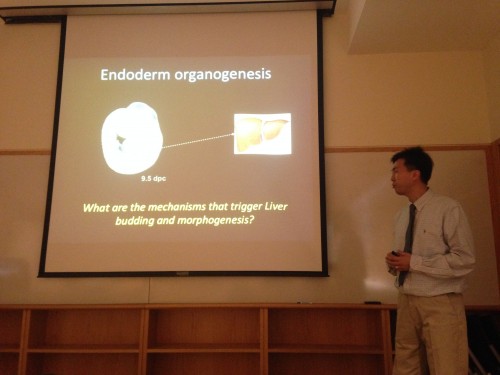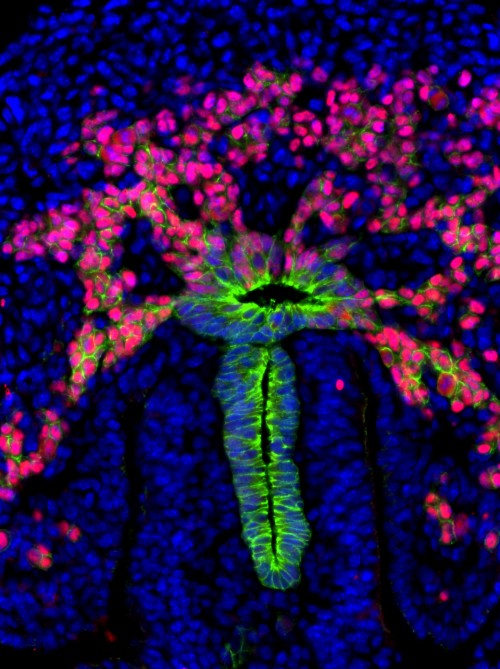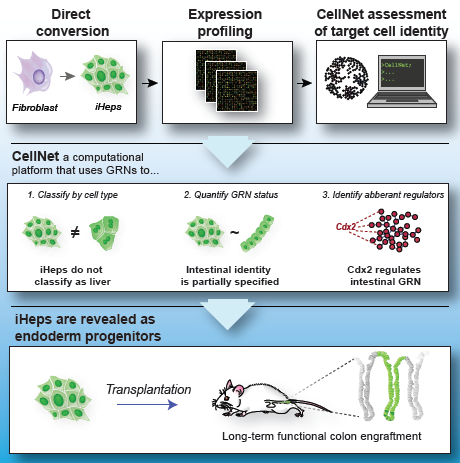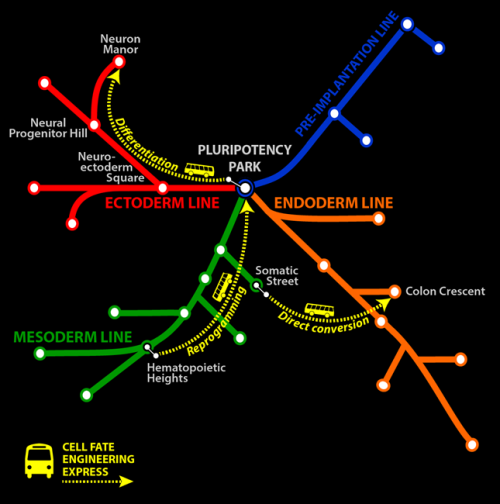Livers in development: YEN USA June Meeting
Posted by Gary McDowell, on 28 June 2015
Frontal section image of mouse embryo with liver marker showing two different liver precursor populations invading and migrating into two different liver lobes (Siyeon Rhee).
Continuing the effort to bring young developmental biology researchers in the Boston area together, in a similar vein to the Young Embryologist Network in the UK, and following on from our previous meeting, on June 18th the second YEN USA meeting was held at Harvard Medical School as advertised on the Node recently.
The first talk was given by Siyeon Rhee (or rather Dr. Siyeon Rhee, as he had just successfully defended his thesis!), a graduate student at University of Massachusetts Amherst in Kimberly Tremblay’s lab, talking about the role of Yin-Yang1 (YY1) in liver specification. He discussed, from his work in mouse, how YY1 is required for embryonic development, in maintaining VEGF in the visceral endoderm of the yolk sac (Rhee et al., 2013) and also explained his work demonstrating two spatially and temporally distinct waves of liver bud specification that lead to formation of distinct lobes in the liver (Wang et al., 2014). Siyeon is about to move to California to start a postdoc position.
 Siyeon Rhee presenting his work.
Siyeon Rhee presenting his work.
The next talk was from Dr. Samantha Morris, a postdoc in George Daley’s Lab at Boston Children’s Hospital, who is also moving, on July 1st, to start her own lab in the departments of genetics and developmental biology at Washington University in St Louis. She spoke about her work and collaboration with computational biologists to assess cellular identity using network biology (Cahan et al., 2014a) and in particular, assessing the fate of cells in direct conversion protocols using CellNet (Cahan et al., 2014b) to directly test and improve direct conversion of cells from one differentiated state to another (Morris et al., 2014).
A graphical abstract of Sam Morris’ work.
Left, Samantha Morris presenting her work; Right, a close up of her diagram of typical developmental pathways illustrating the principle of direct conversion.
Sam’s written a review that covers the current technologies to reprogram cells (Morris and Daley, 2013). Sam went on to speak about her work progressing into the investigation of liver cell fates, which she will now take onwards in developing her own lab.
Please check out the website and get in touch if you’re interested – the next meeting will happen in September, with the Node’s very own Cat Vicente speaking, so stay tuned for future updates!
References
Rhee S., Guerrero-Zayas M.-I., Wallingford M. C., Ortiz-Pineda P., Mager J., Tremblay K. D. (2013) Visceral Endoderm Expression of Yin-Yang1 (YY1) Is Required for VEGFA Maintenance and Yolk Sac Development. PLoS ONE 8(3): e58828. doi: 10.1371/journal.pone.0058828
Wang J., Rhee S., Palaria A. and Tremblay K. D. (2015) FGF signaling is required for anterior but not posterior specification of the murine liver bud. Dev. Dyn., 244: 431–443. doi: 10.1002/dvdy.24215
Cahan P., Morris S. A., Collins J. J. and Daley G. Q. (2014a) Defining cellular identity through network biology Cell Cycle 13(21): 3313-3314. doi: 10.4161/15384101.2014.972918
Cahan P., Morris S. A., Lummertz da Rocha E., Daley G. Q., Collins J. J. (2014b) CellNet: Network Biology Applied to Stem Cell Engineering Cell 158(4): 903-15. doi: 10.1016/j.cell.2014.07.020
Morris S. A., Cahan P., Li H., Zhao A. M., San Roman A. K., Shivdasani R. A., Collins J. J., Daley G. Q. (2014) Dissecting Engineered Cell Types and Enhancing Cell Fate Conversion via CellNet Cell 158(4): 889-902. doi: 10.1016/j.cell.2014.07.021
Morris S. A. and Daley G. Q. (2013) A blueprint for engineering cell fate: current technologies to reprogram cell identity. Cell Research 23: 33-48. doi: 10.1038/cr.2013.1






 (4 votes)
(4 votes)